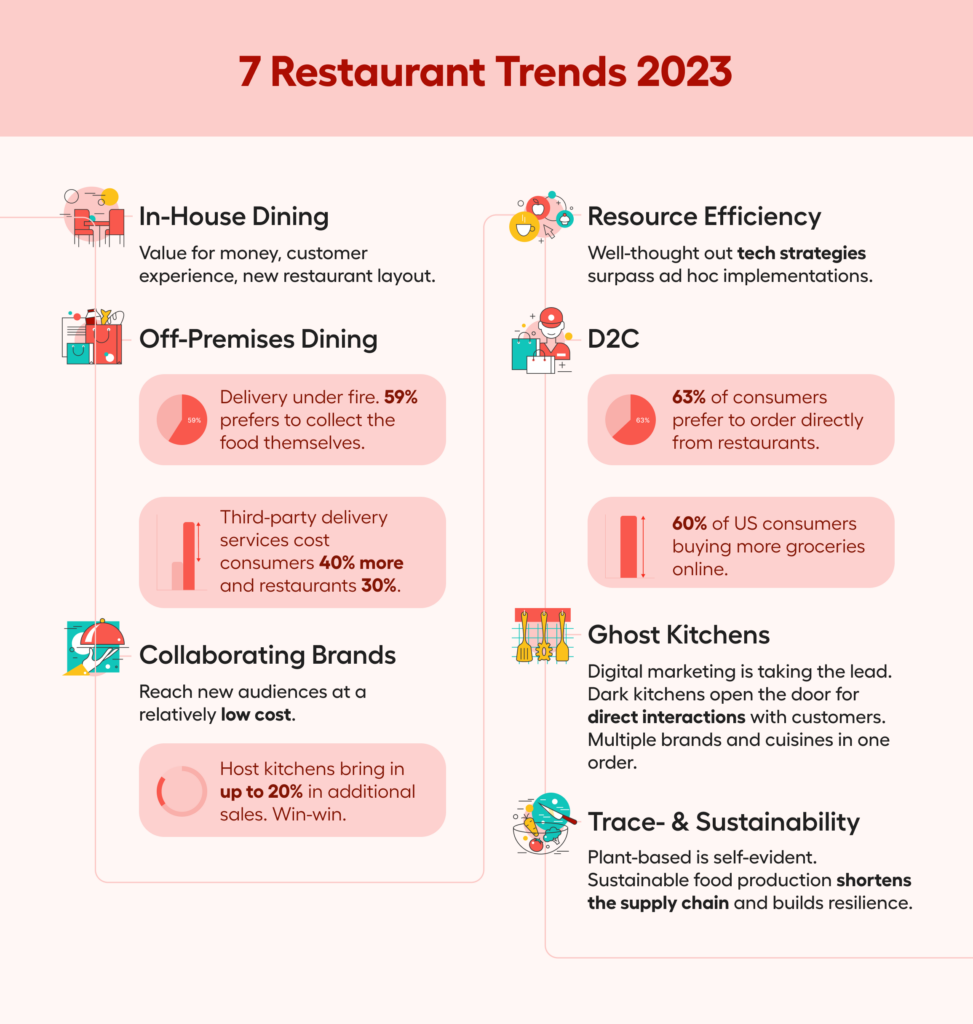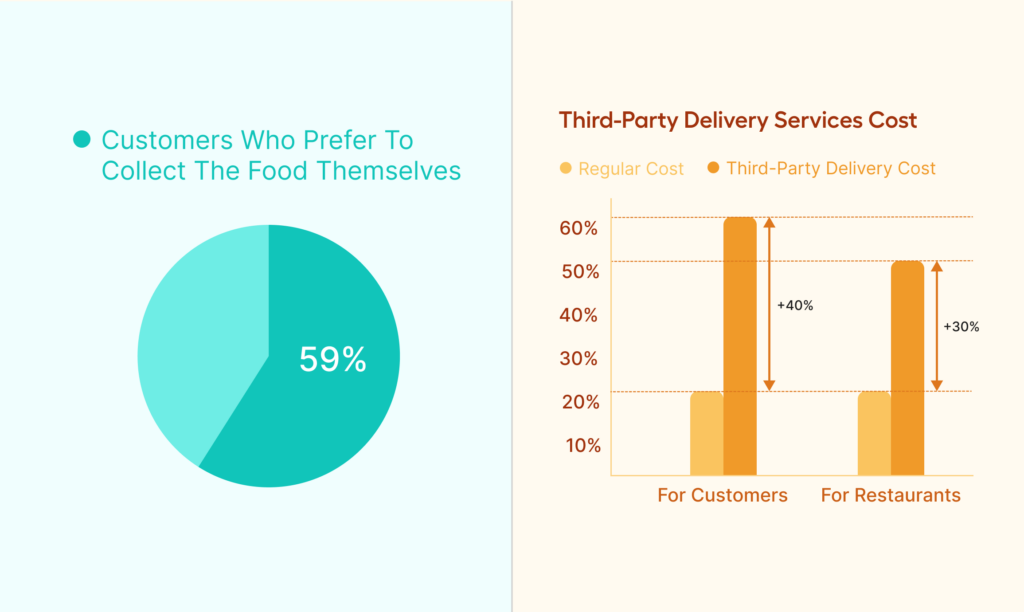14 Feb, 2023
4 Restaurant Trends To Watch In 2023
Many market forces that shaped the restaurant industry over the past few years were linked to the disruptions caused by the global pandemic. But despite the aftermath, the sector has gradually recovered by 2022 – to a point where a new sense of normality has set in.
However, normality is not the same as stability. The feeling of being in a transitional phase prevails among managers and industry experts.
It begs the question: which new challenges and opportunities will the new year bring? What will customers expect from food and hospitality brands? Which consumer trends are up-and-coming, and how will they define what’s next for the industry?
Predicting trends in the food-service industry is never easy because things change constantly. We can, however, tell you that restaurants will have to be more flexible in 2023 than ever to meet customer demand while running ultra-efficient operations.
In addition, creating an exceptional customer experience at all touchpoints remains crucial to attracting customers, building loyalty and ensuring a stable revenue stream.
Keep reading to discover what else restaurateurs, dark kitchens and (virtual) food brands can expect in the coming year (and beyond).
#1 In-house Dining Is Back, But Not As It Was
If there was ever any doubt about whether people would still go out to restaurants, that doubt has since subsided. We were all more than ready to return to our favourite restaurants and discover new spots.
But there’s a catch. Under the current global economic conditions (hello inflation, rising commodity and energy prices), those spending money on dining out expect a restaurant to get it exactly right.
- A beyond-great customer experience. In other words, you’ll need to provide excellent service and an attractive menu you’ve engineered based on data. Additionally, hygiene and food safety standards are still very much on people’s minds (as they should be!), so don’t forget to show customers these are still at the top of your priority list.
- Value for money is key. It always was and always will be, but today’s economy has made it even more outspoken. That means restaurants must reflect on their offer and how it affects their bottom line.

#2 Off-premise Dining Is Evolving
While food brands no longer depend solely on delivery and takeaway to survive, off-premises ordering still isn’t going anywhere. Consumers visit restaurants more often, but online delivery and takeout platforms still attract vast (and hungry) audiences looking to enjoy restaurant quality from their homes and workplaces.
Ghost kitchens open doors to customers.
- Delivery under fire. Despite its popularity, the online food delivery space has come under fire. Consumers and restaurants have become more aware of issues surrounding food delivery companies. Critics claim that third-party delivery services can cost consumers 40% more and restaurants 30%. Additionally, there are numerous accounts from delivery couriers who face poor working conditions, benefits, and low wages.
- Alternatives to capture off-premises orders. Without a doubt, third-party food delivery platforms will feel the added pressure as restaurants look into other options to capture off-premises orders. This year, we’ve seen that many restaurateurs arecreating their own online ordering stores so they can own the entire experience, get big data, and directly receive customer feedback.
- Direct orders. On the other end, a recent study from Sense360 showed that 63% of consumers prefer to order directly from restaurants. This encouraging trend confirms customers are rallying behind their favourite local business owners to help them weather these difficult times. (Also see #5)
- Order-ahead pickup. With this in mind, it’s no surprise that order-ahead pickup is gaining momentum. A recent study by Statista found that 59% of customers, on average, would be willing to spend more money on food services if they could purchase online but collect the order in the establishment instead of having it delivered. Pickup also makes sense from a restaurant operator’s point of view, as it is cheaper, and the restaurant remains in control of all touchpoints (see also #5 D2C is picking up speed).

#3 D2C – Cutting Out The Middle Man
recent survey from Sense360 showed that 63% of consumers prefer to order directly from restaurants. Online food orders aren’t going anywhere, so it’s no surprise that restaurants are exploring 1st party ordering channels to reap the many D2C (Direct to Customer) delivery benefits.
3rd party online ordering is still king, but 1st party could snatch the crown.
Benefits include:
- End-to-end control of the ordering and delivery experience
- Ownership of customer data which enables personalised marketing and relationship building
- Getting more insights into sales and consumer trends, facilitating new product development
- Better margins as you eliminate the middleman (in this case, third-party delivery services and fulfilment partners)
Developing an in-house app for online orders that offers a top-notch user experience seems to be the biggest challenge at the moment. We see things smoothing out in the short term, though. Well-performing solutions have already entered the market.
#4 Ghost Kitchens Are Switching Things Up
he ghost kitchen concept – delivery-only restaurants without a storefront – has seen explosive growth over the past few years. Unfortunately, that has resulted in delivery platforms like DoorDash and Uber Eats being overcrowded with ghost kitchens and virtual brands. And with more consumers returning to in-house dining, these brands may find it challenging to stand out and build a loyal customer base.
Hybrid ghost kitchens open doors to let customers in.
- Strategy & efficiency. Ghost kitchens looking to succeed need to double down on their marketing strategy, ensure their kitchen runs as efficiently as possible and optimise their menu.
- Hybrid models. This year we’ll see dark kitchens switching things up by adopting a hybrid business model, including multiple sales and fulfilment channels. We predict an increase in online orders with pickup and on-premise takeout orders via self-service kiosks for Europe. Dark kitchens are turning to self-service kiosks to improve customer service and connect with customers on-site. Additionally, the kiosks allow ghost kitchens to gather customer data and provide tailored offers and loyalty programs.
- Food halls. We’ve seen ghost kitchens open up food halls where multiple restaurants come together in a shared kitchen and dining space with an online ordering option. The benefit for customers is that they aren’t limited to a specific cuisine or brand. The same order can include items from the menus of Pops Pizza, Big Ben’s BBQ Ribs and Kaiser Soze Pad Thai.
- Collaborations. Another great way to add value to your ghost kitchen or virtual restaurant is by collaborating with other popular brands and chefs to create exclusive delivery-only dishes or give a (limited-time) spin on your signature dishes.
